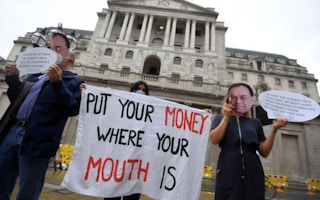Back in 2009, at the UN climate summit in Copenhagen, Denmark, rich countries first set a goal of channelling $100 billion in public and private finance each year to help developing nations tackle climate change.
The promise - due to kick in from 2020, with a gradual increase to that level in the years leading up to it - was made again at COP21 in Paris in 2015. The year 2020 has come and gone, but this money has likely not been delivered. We still do not know how much has been provided because no one keeps agreed, reliable and up-to-date figures.
The donors themselves, in estimates compiled by the Organisation for Economic Co-operation and Development, say they mobilised nearly $80 billion in 2018. But Oxfam’s analysis of these numbers says only $20 billion was provided as grants and should therefore be counted towards the $100-billion goal.
Alok Sharma, the British official who will preside over the COP26 climate talks this November in Glasgow, has called the $100 billion a “totemic” figure that developed countries must provide to retain any semblance of credibility in the UN process.
“
It is therefore clear that rich countries have simply decided to ignore this collective finance commitment - and each country is calculating for itself what it is supposed to provide and what they will count towards their respective share.
The G7 leaders, meeting in Cornwall in Britain last weekend, issued a communique touching on their plans increase their climate finance and meet the goal – but failed to provide clarity on how, and simply punted the decision to the next meeting of the G20 taking place in Italy in September.
It is therefore clear that rich countries have simply decided to ignore this collective finance commitment - and each country is calculating for itself what it is supposed to provide and what they will count towards their respective share.
Going forward towards COP26, the issue of the $100 billion has to be resolved before November – and if possible, at the G20 meeting.
Here are the conditions that need to be met:
1. Each country providing funds must say how much will go to emissions reduction efforts and how much to adaptation, and through which channels. Vulnerable developing countries have demanded that each donor provide 50 per cent of their contribution for adaptation in the form of grants not loans.
2. The developed countries must agree on a formula for determining how much each will contribute to reach the shared $100-billion goal. The fact that they have not yet done so, even six years after confirming the initial pledge, casts their sincerity into doubt.
3. Developed countries also should define on what basis they will make up any shortfall in 2020 and deliver the full amount each year through to 2025, when a new, higher goal will be set. There needs to be an agreed mechanism for transparently tracking this money.
Finally, it should not be forgotten that the amount of $100 billion is not at all commensurate with the scale of climate finance required to help developing nations adopt clean energy and adapt to worsening extreme weather and rising seas.
The sums needed are in the trillions rather than the hundreds of billions. Meeting that outstanding “totemic” pledge is, however, a test of whether wealthy large-emitting nations will negotiate with their counterparts in the Global South on tackling the climate crisis in good or bad faith.
If the money is not delivered before November, then there is little point in climate-vulnerable nations showing up in Glasgow to do business with governments that break their promises.
Saleemul Huq is director of the International Centre for Climate Change and Development.
This story was published with permission from Thomson Reuters Foundation, the charitable arm of Thomson Reuters, that covers humanitarian news, climate change, resilience, women’s rights, trafficking and property rights. Visit http://news.trust.org/climate.











